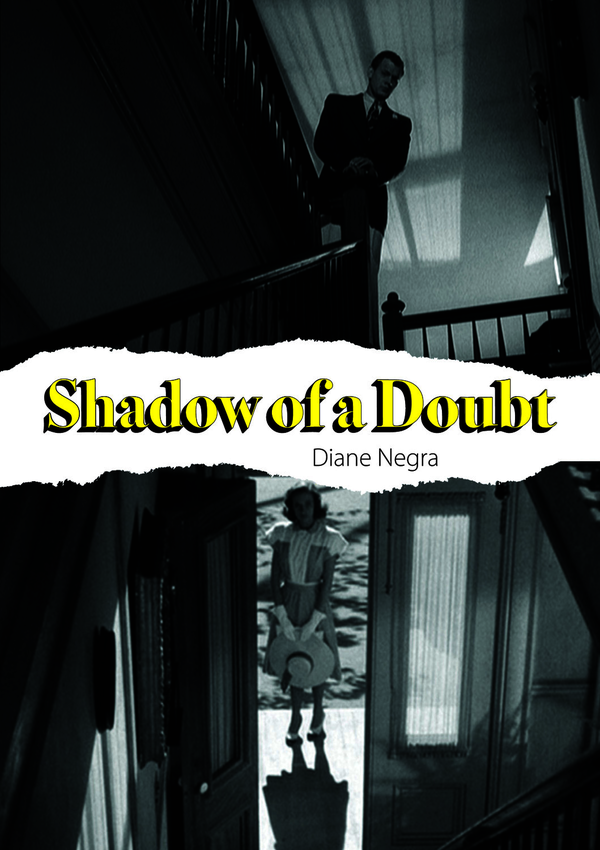
Shadow of a Doubt (1943) was British-born Alfred Hitchcock’s sixth American film and the one that he at various times identified as his favourite and his best. This book redresses the deficit of sustained critical attention paid to Shadow even in the large corpus of Hitchcock scholarship.
Analysing the film’s narrative system, issues of genre, authorship, social history, homesickness and ‘family values’, Diane Negra shows how the film’s impeccable narrative structure is wedded to radical ideological content, linking the film’s terrors to the punishing effects of looking beyond conventional family and gender roles. This book understands Shadow as an unconventionally female-centred Hitchcock text and a milestone film that marks the director’s emergent engagement with the pathologies of violence in American life and opens a window into the placement of femininity in World War II consensus culture and more broadly into the politics of mid-century gender and family life.
Pre-order online for a 30% discount – use discount code SHADOW30 at check-out
Hamilton Carroll (HC): The relative paucity of criticism on Shadow of a Doubt (which you note) has always been something of a mystery to me. Early on in the book you place the relative lack of critical attention paid to the film in juxtaposition with Hitchcock’s own love and regard for it. As you note, he referred to it as both his favorite and his best film (18). Running alongside that is the curious fact that the film is also well-loved by [F]ilm [S]tudies scholars, which begs the question: why, then, have they paid it so little critical attention?
Diane Negra (DN): Yes, one of the great pleasures of working on this book was the frequency with which academics and non-academics mentioned to me how much they love the movie.
Hitchcock scholarship is still a more traditional corner of Film Studies and I suggest in the book that the perspectival centrality Shadow gives to a female teenager may be a roadblock for some. Even though there are some thematic congruities between Shadow and Vertigo, for example, it’s the latter that consistently tops the “Best Film” lists. Much of the scholarship on Hitchcock’s films, particularly the early work, isn’t taking a feminist line and that work that does focuses on films other than Shadow. And I should add that the 1940s woman’s film has traditionally been a key site for the working out of feminist film theory, but Shadow doesn’t get much play there either. To be fair, anyone teaching a Hitchcock course has tough choices to make about what can fit in and what can’t but whatever the reasons for the film’s pedagogical neglect, I hope this book will serve as a resource for changing that.

HC: You argue that “Shadow is a film whose meticulous craft and ideological richness warrant the placement of it at or near the center of the Hitchcock canon” (25). Later on, you say that the film “richly delivers on spectatorial expectations for internal cohesiveness and wholeness” (36). I wonder whether what you call the film’s “meticulous craft” and “wholeness” isn’t, in fact, one of the reasons why its ‘”deological richness” has been somewhat overlooked? Befitting its subject, the film “hides” its richness behind its all-but-seamless formal veneer (much as the middle-class family hides its horrors behind social convention). Its formal perfection makes it appear to be a less ideologically significant film than it actually is. Its critique is so easily digested that it hardly feels like critique at all.
DN: That’s a shrewd observation and it strikes me as accurate. I’m trying to demonstrate the need to analyze the film on both levels and to show how the aesthetic proficiency serves the ideological scrutiny Shadow provides of dominant institutions, not least the family.
Your point about how in Shadow “critique is so easily digested that it hardly feels like critique at all” is one that I somewhat agree with although I don’t think most viewers miss the deep irony of the film concluding with everyone in town turning out for the funeral of a serial killer who shortly before his death has been told by the minister that “we feel you’re one of us.” But there are critics and fans of the film who, remarkably in my view, characterize Shadow as arriving at a “happy ending.”

HC: As I see it, the book’s central critical claim, which I think is absolutely correct (and very persuasively argued), is that Shadow of a Doubt should be viewed as a family romance, which is “deeply interest[ed] in the unspeakable elements of middle-class family life and of the family’s relation to the social protocols of the community” (31). “It’s greatest significance,” you argue, “may lie in its status as a master narrative of American life” (31).
If this is the case – and your argument is entirely persuasive that it is – then it is a remarkable achievement for a director so recently arrived on American shores and tackling what you observe is his first wholly “American” film.
DN: Yes, I do think there is a sharp expatriate gaze at work in the film (and it may not just be Hitchcock’s, it may also be Alma Reville’s). Shadow really stands out among early US Hitchcock films for its acute sense of place and culture. Arguably US Film Studies could do more to consider the frequency with which diagnostic depictions of national culture are associated with expatriate creative personnel. The perspective of someone from outside a culture in which a creative work is set can be particularly insightful as we see in much of Hitchcock’s American work. Of course, that outsider perspective can also be quite removed from life as it’s lived in that setting. An awareness of this comes naturally in Ireland, a small nation with a large diaspora and an even greater number of people around the world who feel some sense of affiliation with “Irishness.“ Living here one tends to be highly aware of the representational clout of creative practitioners with generally greater access to financial and cultural capital who may or may not know much about Ireland but who play a powerful role when it comes to how the nation is depicted onscreen.

HC: It’s also almost unique amongst Hitchcock’s films in that it contains (and is centered around) a nuclear family. There are very few children in Hitchcock’s films (which might be another reason that Shadow appears to some to be a marginal or incidental entry in the Hitchcock canon). The film’s paranoid and troubled man is an uncle and its female protagonist is a niece.
DN: In various ways and for various reasons I think the film manifests considerable sympathy for the Newton children, particularly Ann who as played by Edna May Wonacott seems to have been cast and coached in part for her resemblance to Patricia Hitchcock. Ann and Roger perform little bits of seemingly marginal business throughout the film that turn out to be telling. Ann’s conspicuous disappointment with a gift from Charles that seems too baby-ish for her is one since it highlights by contrast how carefully chosen and meaningful Charles’ gifts are for Emma and Charlie. Roger’s attraction to the train in the film’s conclusion and his seeming hope that he’ll be carried away on it out of Santa Rosa (the little boy says excitedly “Maybe it’s too late, maybe I’ll have to go along”) is likewise significant.

HC: At the same time, the film’s refusal to resolve the tensions that it finds at the heart of the (American) family is a key aspect of its depth. I’m always struck by how radical (to use a term that you use in a slightly different context) the ending of the film actually is: in order to “save” the family, Charlie must kill her uncle but then return to the fold unchanged (on the surface at least). Her lot is still to be married, to conform to conservative social expectations, even though she has had a singular experience. That’s an extraordinary burden that the film imagines for its young, female protagonist.
In your discussion of Charlie as a girl detective you observe that “female agency, capacity and resilience were key concerns of the wartime period” (71), something that you link earlier to the rise of the female teenager (32) in the period. It is also the case that, as you observe, Charlie is considerably younger than the typical Hitchcock female protagonist. This is – in the pseudo-incestuous nature of her relationship with her uncle – something about which the film betrays no small degree of concern. There is a degree to which the unhappy and questioning Charlie that the viewer is introduced to at the start of the film is as much of a threat to the moral order as Charles. Do you think that the confrontation with her uncle is one aspect of Charlie’s “education”? By “saving” the family, she is returned to it and her impulse towards critique and independence (that is so in evidence early in the film) is harnessed and subverted.
DN: Yes, I do think Charlie’s experience with her uncle and the disenchantment that comes from learning who he really is has an educational character. This is a coming-of-age story that strikingly closes in a paralytic rather than dynamic mode. Charlie is speaking a little bit to herself as she stands with Graham outside the church at Charles’ funeral – in this way she resembles her mother who has a habit of speaking her insights to herself.
Shadow’s wartime context and sensibility seemed more and more important to me as I progressed through my research and each time I taught the film it also seemed more apparent. The film is bookended in Hitchcock’s body of work by features and shorts with a wartime consciousness – Saboteur in 1942 and then Lifeboat and The Fighting Generation (a short propaganda piece) in 1944. I do think it’s a mistake to miss how connected this film is to the wartime milieu even if in a less obvious way than some other Hitchcock films and I try to make the case for that in the book.
HC: There’s a very different Hitchcock film in waiting there, one that begins with Charles’s death at the hands of his niece and then follows Charlie’s attempt to evade capture for long enough to absolve herself of guilt by proving that he was the Merry Widow Strangler and that she was acting in self-defense. North by Northwest meets Thelma and Louise…

DN: Ha, yes, The 39 Steps would be mixed in there as well – this makes me think a little bit of the end of Stoker (2013) which is one of a number of contemporary films that invoke Shadow. In the conclusion of that film India Stoker takes to the road heading for New York.
HC: You refer to the scene when Charles gives Charlie the stolen ring as a “betrothal scene” and cite it as evidence of “just how radical the film is prepared to be when it comes to conventional gender and family relationships” (41). This radicalness is also apparent in something that you discuss slightly earlier, which is the status of Charles’s relationship to the family. As you state, “while it is indisputable that Charles is a threat to the Newtons, the question of whether he should be understood as external or intrinsic to the family unit might be difficult to parse but stands at the heart of the film and its meanings” (37). The film isn’t an escape from daily life but a mirror being held up to it.
In an example of your scrupulous attention to the film’s formal characteristics, you refer to it towards the end of your study as a “spatially meticulous film” that “thematically organizes space” (93). This is wonderfully illustrated in the use of the front and back of the Newton home to symbolically represent the “public” and “private” faces of the family.
You explicitly place your discussion of the film within current socio-cultural debates that have arisen in recent years: [#]MeToo (25), gaslighting (60), and “breath play”/strangulation and sexual violence (61). Such debates are, as you note, contexts in which viewers will engage with both the film and its director but, at the same time, Shadow of a Doubt is a film that relied on the skills of so many talented women (as so many of Hitchcock’s films did).
DN: This, for me, is a crucial point. Hitchcock’s authorship is customarily exalted and the authorship of his female collaborators suppressed. Male authorship is also often an archival logic and this is something to bear in mind when we do research in archives – we should try to be cognizant of what criteria might have shaped decision-making about the selection and retention of historical records. I think we can learn a lot from Christina Lane’s book Phantom Lady, a biography of Joan Harrison, the producer who collaborated with Hitchcock over a number of years. That kind of work is very useful in dislodging what have sometimes seemed like fixed paradigms of male authorship in cinema.


